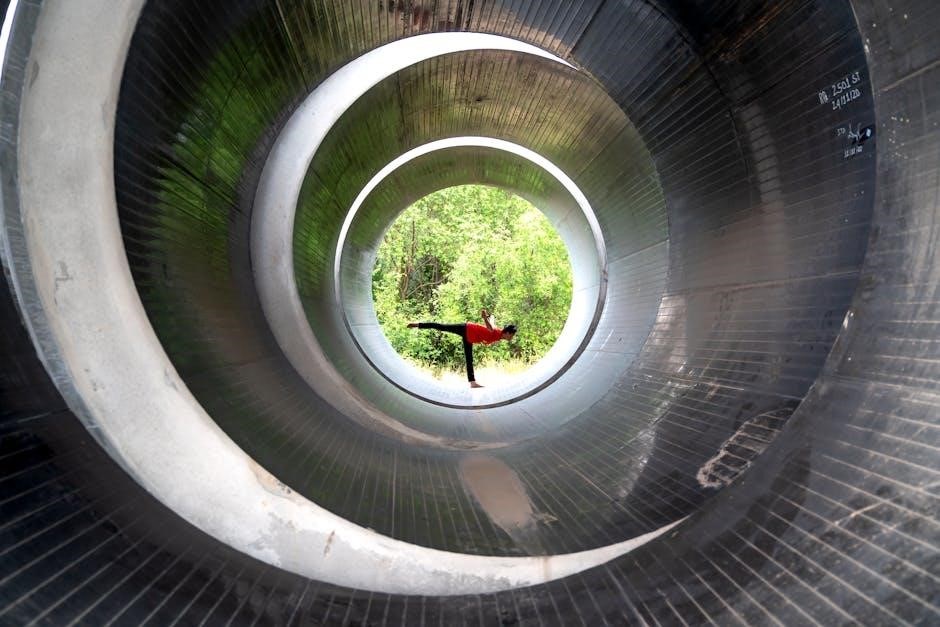Tarsal Tunnel Syndrome (TTS) is a condition caused by compression of the tibial nerve near the ankle, leading to pain, numbness, or tingling in the foot.
1.1 What is Tarsal Tunnel Syndrome?
Tarsal Tunnel Syndrome (TTS) is a condition caused by compression of the tibial nerve near the ankle. The tibial nerve passes through the tarsal tunnel, a narrow space on the inner side of the ankle, alongside tendons and blood vessels. Compression of this nerve leads to symptoms like pain, numbness, and tingling, often radiating to the heel, arch, and toes.
1.2 Symptoms and Diagnosis
Symptoms of TTS include sharp pain, numbness, or tingling in the foot, often worsening with activity. Diagnosis involves clinical exams, nerve conduction studies, and imaging. Early detection is key for effective management, often through exercises and orthotics.
1.3 Importance of Exercises in Managing TTS
Exercises are crucial in managing TTS, reducing pain and improving mobility. Stretching and strengthening routines target the tibial nerve and surrounding muscles, preventing further nerve compression. Early intervention with exercises can delay or avoid surgical options, promoting long-term recovery and functionality.

Stretching Exercises for TTS
Stretching exercises relieve tension around the tibial nerve, improving flexibility and reducing pain. Techniques like tibial nerve stretches and calf stretches are commonly recommended;
2.1 Tibial Nerve Stretch
To perform the tibial nerve stretch, place a towel or belt under the ball of your foot. Gently pull upward, stretching the heel and calf. Hold for 20 seconds, ensuring a mild stretch without pain. This exercise helps relieve tibial nerve compression and improves foot mobility, essential for managing TTS symptoms effectively.
2.2 Calf Stretch
Stand facing a wall, one hand on the wall for balance. Step one foot back about a foot, keeping the heel on the ground. Bend the front knee slightly until a gentle stretch is felt in the calf. Hold for 20 seconds, then switch sides. This stretch reduces tension on the tibial nerve, helping to alleviate TTS symptoms.
2.3 Achilles Tendon Stretch
Stand with your feet shoulder-width apart. Step forward with one foot and lower your body slightly, keeping the back heel on the ground. Lean forward until a stretch is felt in the Achilles tendon. Hold for 20-30 seconds, then switch sides. This stretch helps reduce tension on the tibial nerve and improves ankle mobility, aiding TTS recovery.
Strengthening Exercises
Strengthening exercises target muscles around the foot and ankle, improving stability and reducing strain on the tibial nerve, essential for managing Tarsal Tunnel Syndrome effectively.
3.1 Resisted Ankle Inversion
Resisted Ankle Inversion strengthens the tibialis posterior muscle by contracting it without foot movement. Use a resistance band or manual resistance, holding for 5 seconds. Repeat 10-15 repetitions, 3 sets daily. This exercise improves arch support and reduces tibial nerve compression, aiding in TTS recovery and prevention.
3.2 Toe Raises
Toe Raises are simple yet effective for managing TTS. Sit or stand, then slowly lift your toes off the ground, holding for 5-10 seconds. Perform 10-15 repetitions, 3 sets daily. This exercise strengthens toe and foot muscles, supporting the arch and reducing tibial nerve compression. Regular practice helps improve foot mechanics and alleviate TTS symptoms effectively.
3.3 Resistance Band Exercises
Resistance band exercises are excellent for strengthening muscles around the tibial nerve. Loop the band around the ball of your foot and gently pull back while keeping your knee straight. Hold for 5 seconds, then release slowly. Perform 10-12 repetitions, 3 sets daily. This helps improve foot stability and reduces nerve compression, alleviating TTS symptoms effectively over time.

Nerve Gliding and Flossing Exercises
Use a belt or towel to gently stretch the tibial nerve. Wrap it around the ball of your foot and pull back, holding for 20-30 seconds. This improves nerve mobility and reduces compression.
4.1 Tibial Nerve Flossing
Tibial nerve flossing involves wrapping a belt or towel around the ball of the foot. Gently pull the foot upward, stretching the nerve. Hold for 20-30 seconds, repeat 3-5 times. This exercises helps reduce compression, improve circulation, and restore nerve mobility, alleviating TTS symptoms effectively without causing pain. Regular practice is recommended for optimal results.
4.2 Ankle Mobilization Techniques
Ankle mobilization techniques involve gentle movements to improve joint flexibility and reduce stiffness. Sit on the floor with legs extended, loop a towel around the foot, and gently pull to stretch. Focus on upward and outward motions. Perform 3 sets of 10-15 repetitions. These exercises help restore normal ankle function and promote healing in TTS cases effectively.
Foot and Ankle Mobility Exercises
Foot and ankle mobility exercises enhance flexibility and range of motion, reducing stiffness. Activities like toe spreads and gentle ankle rotations promote circulation and alleviate TTS symptoms effectively.
5.1 Toe Spreads and Curls
Toe spreads and curls are simple exercises that improve foot mobility. Sit or stand barefoot, spread toes apart as far as possible, then curl them under. Hold for 5 seconds, repeat 10 times. This strengthens intrinsic foot muscles and enhances circulation, reducing TTS discomfort and improving overall foot function effectively.
5.2 Ankle Alphabet
The ankle alphabet involves tracing each letter of the alphabet with the foot, starting from “A” to “Z.” Sit or stand, lift the foot, and draw letters in the air using the ankle. This exercise enhances ankle mobility, improves nerve gliding, and strengthens the muscles around the tibial nerve, aiding in TTS recovery and preventing stiffness;
Preventive Measures
Use orthotics, proper footwear, and taping to reduce tibial nerve stress, preventing TTS. Avoid improper footwear to minimize arch strain and nerve compression risks.
6.1 Orthotics and Footwear
Orthotics and supportive footwear are crucial for managing TTS. They help reduce foot pronation and alleviate pressure on the tibial nerve. Proper arch support and cushioning can prevent nerve compression, while high-top shoes provide additional ankle stability, reducing the risk of further injury or strain.
6.2 Taping and Bracing
Taping and bracing are effective in providing additional support and stability for the ankle and foot. Taping techniques can help reduce stress on the tibial nerve by redistributing pressure, while braces limit excessive movement and protect the ankle from further injury. These methods are often recommended alongside exercises to enhance recovery and prevent recurrence of TTS symptoms.

Exercise Routine and Progression
A structured exercise routine is essential for managing TTS. Start with daily stretching and gradually incorporate strengthening exercises, ensuring consistent progression to avoid overexertion and promote healing.
7.1 Creating a Daily Routine
Establishing a consistent daily routine is crucial for managing TTS. Begin with gentle stretches like the tibial nerve and calf stretches, followed by strengthening exercises such as resisted ankle inversion. Incorporate nerve gliding techniques to improve mobility. Each session should last about 20-30 minutes, ensuring gradual progression without causing discomfort or strain. Consistency is key to achieving lasting relief and preventing recurrence, so it’s important to maintain this routine diligently. Over time, as symptoms improve, the intensity and duration can be adjusted to further enhance strength and flexibility, promoting overall foot and ankle health.
7.2 Gradually Increasing Intensity
As symptoms improve, gradually increase the intensity of exercises to enhance strength and flexibility. Start with low-resistance bands or light weights, then progress to higher resistance. Incorporate dynamic stretches and balance exercises to improve ankle stability. Monitor symptoms to avoid overexertion, ensuring a safe and effective progression. This approach helps prevent relapse and promotes long-term recovery;

Common Mistakes to Avoid
Avoid overexertion, improper footwear, and inconsistent exercise routines. Overstretching can worsen symptoms, while neglecting professional advice may delay recovery. Consistency and moderation are key to managing TTS effectively.
8.1 Overstretching
Overstretching can exacerbate TTS symptoms by further irritating the tibial nerve. Gentle, controlled movements are essential to avoid causing additional stress or inflammation. Proper technique ensures the stretch is effective without causing harm. Overstretching may lead to increased pain or prolonged recovery. Always prioritize moderate stretching and consult a professional if symptoms worsen or persist.
8.2 Improper Footwear
Improper footwear can worsen TTS symptoms by increasing pressure on the tibial nerve. Tight shoes or those with poor arch support exacerbate discomfort and nerve irritation. High heels and unsupportive footwear are particularly problematic. Wearing orthotics or shoes with sturdy arch support can help alleviate symptoms and prevent further nerve compression. Proper footwear is essential for managing TTS effectively.

When to Seek Professional Help
If symptoms persist despite self-care, or if severe pain, numbness, or tingling occurs, consult a healthcare professional for proper diagnosis and treatment options.
9.1 Persistent Pain
Persistent pain in the foot, arch, or calf that doesn’t improve with rest or exercises may indicate a need for professional evaluation. A healthcare provider can assess if symptoms are worsening or if underlying issues, such as nerve damage, require medical intervention like physical therapy or orthotics. Early intervention is crucial for effective recovery.
9.2 Numbness or Tingling
Numbness or tingling sensations in the foot, especially near the arch or toes, can signal nerve compression. If these symptoms persist or worsen, seek professional help. A healthcare provider may recommend nerve gliding exercises, orthotics, or physical therapy to alleviate discomfort and prevent further nerve damage, ensuring proper nerve function and mobility are restored effectively.
Consistent exercises and proper footwear can alleviate TTS symptoms. For further guidance, consult a healthcare professional or refer to detailed exercise guides and resources online.
10.1 Summary of Key Exercises
Consistent practice of tibial nerve stretches, calf stretches, and resisted ankle inversion can alleviate TTS symptoms. Strengthening exercises like toe raises and resistance band workouts are also beneficial. Nerve gliding and foot mobility exercises, such as toe spreads and ankle alphabet, promote flexibility and reduce compression. Regular practice of these exercises can significantly improve symptoms and overall foot function.
10.2 Recommended Reading and References
For comprehensive guidance, the TTS exercise leaflet from Hinge Health is highly recommended. Additionally, research papers on orthotic considerations and nerve gliding techniques provide valuable insights. The September 6, 2023, article on pronation and arch stress offers practical solutions, while the September 25, 2023, guide details effective stretching methods for symptom relief and long-term management of TTS.

Leave a Reply
You must be logged in to post a comment.